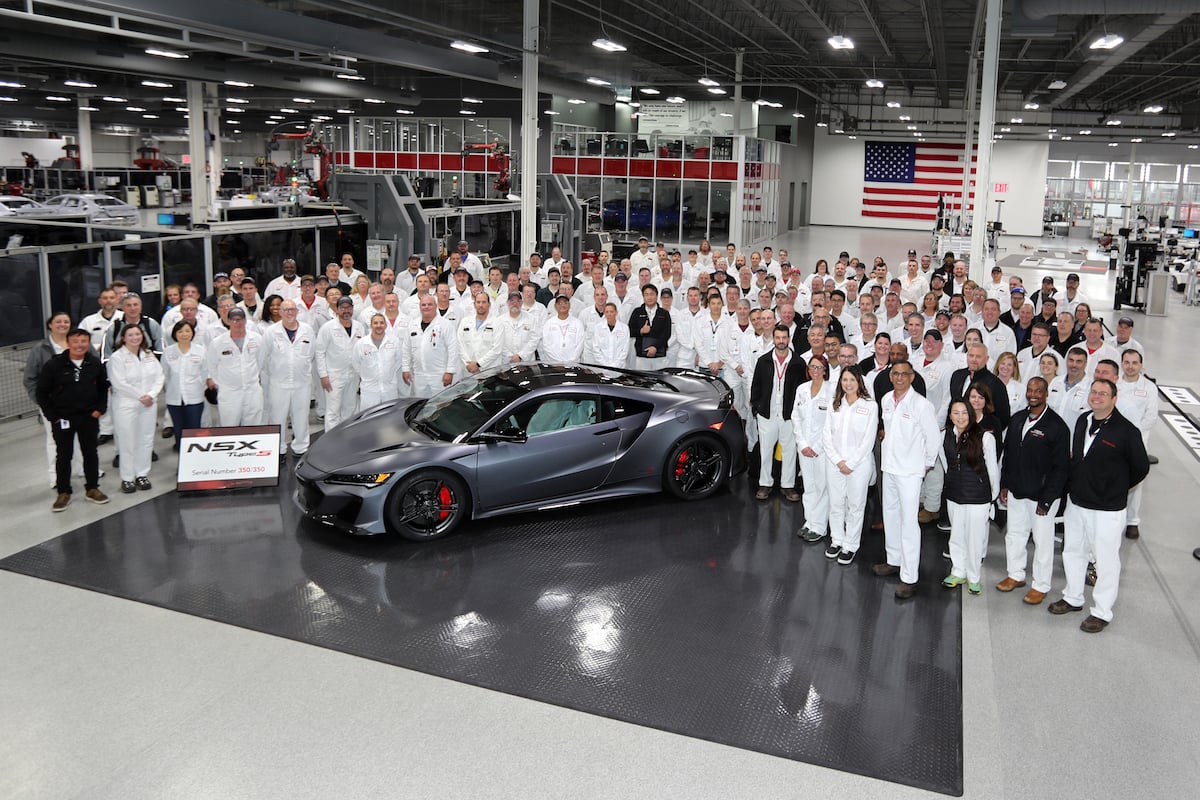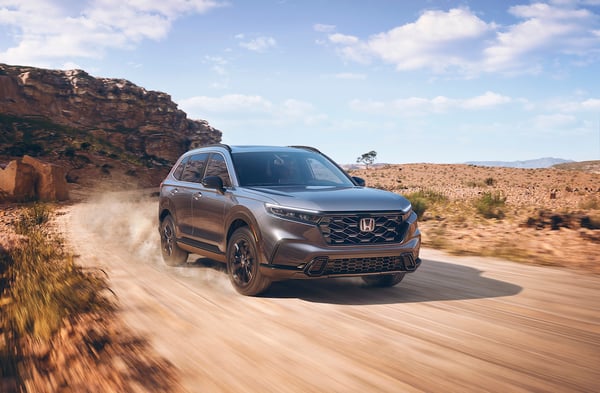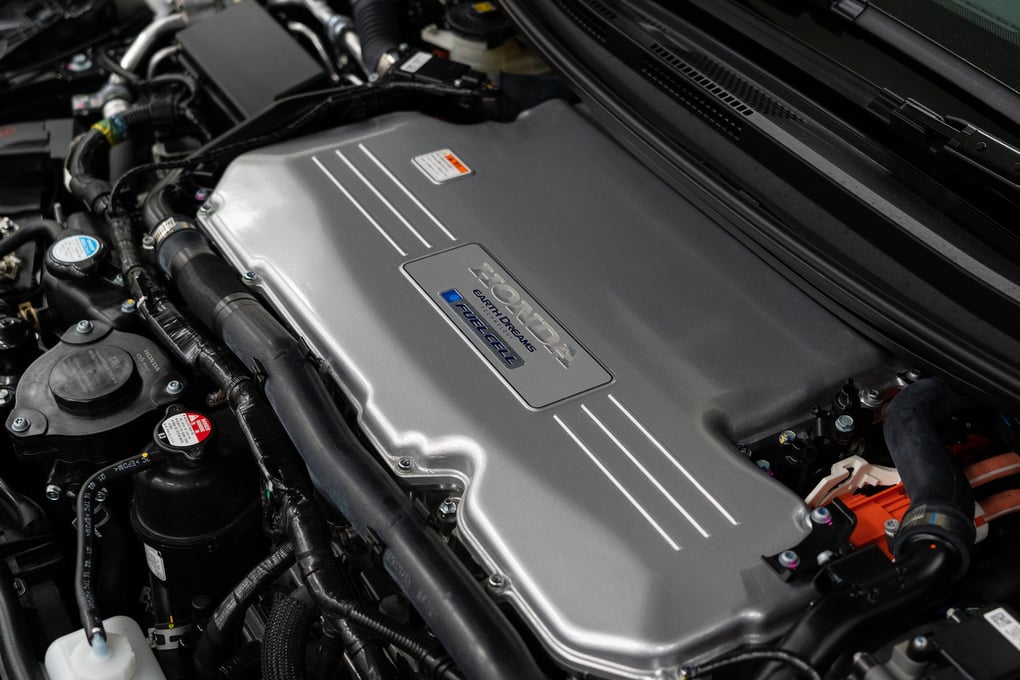Honda isn't giving up on fuel cell vehicles, despite discontinuing the Clarity FCEV. The automaker is now announcing plans to build a new all-electric fuel cell vehicle starting in 2024. The automaker says it will be based on the recently launched all-new 2023 Honda CR-V. Honda discontinued production of the Clarity FCEV back in 2021 due to slow sales (it was only sold in California), so the only FCEVs currently on sale in the U.S. are the Hyundai Nexo SUV and Toyota Mirai.
New CR-V-Based FCEV
Honda says the CR-V-based FCEV will be the first production vehicle in North America to combine a plug-in feature with FCEV technology in one model. It will enable the driver to charge the onboard battery to deliver EV driving around town but also provide the fast hydrogen refueling for longer trips.
Honda says the new model is part of previously announced plans to make battery electric vehicles (BEVs) and FCEVs represent 100% of its global auto sales by 2040.
“Honda established our goal to realize carbon neutrality by 2050 and the complete electrification of our vehicle lineup by 2040 is critical to achieving it,” said Gary Robinson, vice president of Auto Planning & Strategy for American Honda Motor Co., Inc. “As we accelerate our plan to produce Honda battery EVs in the United States, we also will begin low volume production of fuel cell electric vehicles there to further explore their great potential as part of a sustainable transportation future.”
 Acura completes production of the final second generation NSX at the Performance Manufacturing Center (PMC) in Marysville, Ohio. Credit: Honda.
Acura completes production of the final second generation NSX at the Performance Manufacturing Center (PMC) in Marysville, Ohio. Credit: Honda.The new CR-V based FCEV will be built at Honda's Performance Manufacturing Center in Ohio where the hand-crafted and assembled Acura NSX supercar recently ended production. PMC also responsible for the production of multiple Acura PMC Editions along with Honda Performance Development race cars. Honda says this makes the facility uniquely suited to build high-quality FCEVs, which require special assembly procedures.
“Our associates at the Performance Manufacturing Center have really enjoyed the opportunity to successfully introduce several specialty vehicles into the market,” said PMC plant leader Gail May. “This facility is perfect for production of a new Honda fuel cell electric vehicle, as our small-volume capability enables us to really leverage the skill and expertise of our team to produce quality zero-emission vehicles here in North America.”
2023 Honda CR-V
Honda says the redesigned 2023 CR-V, which launched in September, will provide an excellent foundation for its new FCEV. The automaker says the all-new model sets a new benchmark with its rugged and sophisticated exterior design, sporty and modern interior, more interior space, comfort and performance.
 Honda says the 6th generation CR-V is already playing a key role in the brand's electrification strategy. Honda expects CR-V hybrid-electric models, positioned at the top of the lineup, to represent about 50% of annual CR-V sales.
Honda says the 6th generation CR-V is already playing a key role in the brand's electrification strategy. Honda expects CR-V hybrid-electric models, positioned at the top of the lineup, to represent about 50% of annual CR-V sales.
Honda's Fuel-Cell Leadership
Honda says it's led the industry for more than two decades in the development and deployment of fuel-cell technology - believing that FCEVs powered by hydrogen created through renewable sources will be a key part of a sustainable transportation future. Fuel cell vehicles come with a high-pressure hydrogen tank instead of a conventional gas one. It drives electricity without producing CO2 emissions, with water and heat the only byproducts. Where hydrogen refueling infrastructure is available, Honda says FCEVs can refuel in minutes.
Honda introduces its first commercially available fuel-cell vehicle, the FCX, in 2002. Since then, Honda says it's made significant advancements in fuel-cell vehicle operation in both hot and freezing weather as well as met customer expectations and safety regulations.
Fuel Cell Infrastructure
Like with EVs, FCEV infrastructure is an issue. According to the California Hydrogen Fuel Cell Partnership, as of October 31, 2022, there were only 56 open retail hydrogen stations in California with 115 in development. Honda says it's invested more than $14 million in CA's hydrogen refueling network to spur wider FCEV adoption. It also joined the public-private partnership H2USA in May 2013, which brings together automakers, government agencies, hydrogen suppliers, and the hydrogen and fuel-cell industries to coordinate research and identify cost-effective solutions to deploy infrastructure that can deliver affordable, clean hydrogen fuel in the United States.
Honda cites its fuel cell technology milestones as:
- Honda FCX was the first EPA- and CARB-certified fuel-cell vehicle (July 2002)
- FCX was the world's first production fuel-cell vehicle, introduced to the U.S. and Japan (December 2002)
- First fuel-cell vehicle to start and operate in sub-freezing temperatures (2003)
- First fuel-cell vehicle leased to an individual customer (July 2005)
- First manufacturer to build and produce a dedicated fuel-cell vehicle (FCX Clarity) on a production line specifically made for fuel-cell vehicles (2008)
- First automaker to create a fuel-cell vehicle dealer network (2008)
- Honda entered into a long-term collaborative agreement with General Motors to co-develop the next-generation of fuel-cell systems and hydrogen storage technologies (June 2013)
- As the next progression of Honda FCEVs, Honda introduced the Honda Clarity Fuel Cell (April 2017)
- Honda and GM announced a joint venture (Fuel Cell Systems Manufacturing) working toward mass production of lower cost, compact and high-performance fuel cell systems (2017)
More details about the all-new FCEV version of the CR-V will be announced closer to its introduction in 2024.
Photo Credit: Honda.

